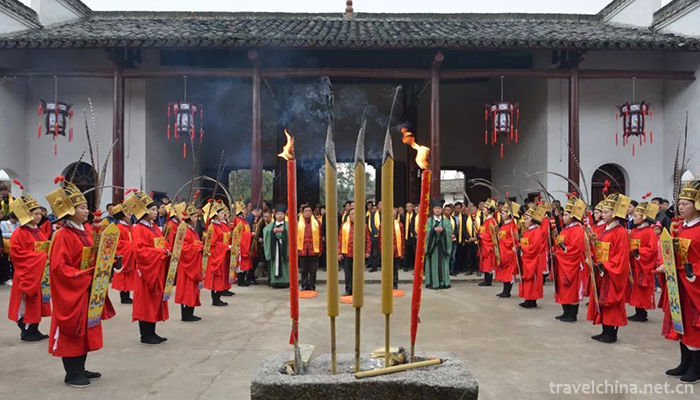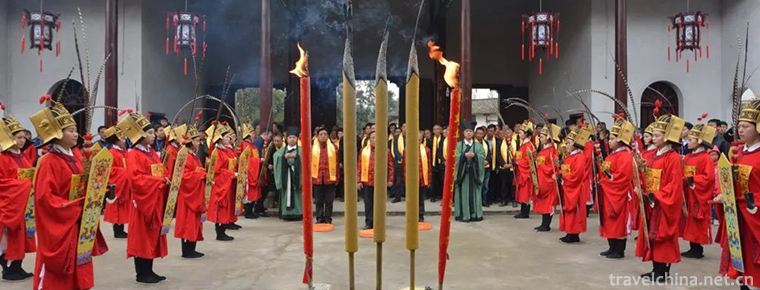Music of Confucius Festival in Liuyang Temple
Music of Confucius Festival in Liuyang Temple
The ancient music of offering sacrifices to Confucius in Liuyang Temple is a traditional folk music in Hunan Province. A list of the second batch of intangible cultural heritage in Hunan Province has been published recently. The "Liuyang Temple for Confucius and Ancient Music" declared by Liuyang City is listed in the category of "folk music".
In 2007, Liuyang City compiled and printed Liuyang intangible cultural heritage series, including Liuyang Ancient Music. According to Pan Xinzhi, the editor-in-chief, Liuyang ancient music was developed by Qiu Zhizhen, an ancient musician of Liuyang, in the ninth year of Qingdaoguang (1829 AD), in accordance with the ancient law. It included music, dance, song and ritual. The performance was very grand. Therefore, music is used in the sacrifice of Confucian temples, so it is called "Confucian ancient music sacrificed by Confucian temples". Liuyang Ancient Music was once known all over the world as "the only thing left in the whole country", especially in the late Qing Dynasty and the early Republic of China. In 1937, Professor Zhang Minjun of Hunan University wrote "The Ancient Rites of National Music in Liuyang" after Liu Guanli, which was published ten years later, reflecting the grand ceremony of sacrificing Confucius at that time.


-
2.China Antique Car Museum
Located on the Houli Cultural Site, the Chinese Ancient Car Museum is the first most systematic and complete Museum in contemporary China, which integrates the Car and Horse Sites with the display of
Time 2018-12-22 -
3.Dazhushan Scenic Area
Dazhushan Scenic Area is located on the southeast coast of Huangdao District. Its main peak is 486 meters with a total area of 65 square kilometers. It is mainly divided into Shimen Temple Scenic Area
Time 2019-01-08 -
4.Gui Yuan Temple
Guiyuan Chan Temple is located in Guiyuan Temple Road, Hanyang District, Wuhan City, Hubei Province. It was built by Master Baiguang in the fifteenth year of Shunzhi Qing Dynasty (1658 A.D.). Covering
Time 2019-01-13 -
5.Maoling Museum
Maoling Museum is located on the Wuling Platform between Xianyang and Xingping in Shaanxi Province, about 40 kilometers away from Xi'an. It is a Museum of Dynastic History of the Western Han Dynasty
Time 2019-02-07 -
6.Sunan Wenshu Temple Scenic Spot
The Sunan Wenshu Temple scenic spot is located at the foot of the Suzhu Chain, the main peak of Qilian Mountain in Sunan County, Gansu Province. It is a national key cultural relic protection unit and
Time 2019-02-13 -
7.Buddhist music
Buddhist music, the music used by Chinese Buddhist temples and believers in religious ceremonies. Buddhism believes that music has the function of "offering" and "praising Buddha".
Time 2019-04-29 -
8.Legend of Mount Tai
Taishan legend is one of the folk legends in Shandong Province. According to legend, the history of the Theocracy of Taishan God in charge of life and death can be traced back to the pre-Qin period. A
Time 2019-06-18 -
9.Inkstone Platform Making Skills
Inkstone production skills, Liaoning Province Benxi City, Ningxia Hui Autonomous Region Yinchuan City, Hebei Province Yi County, Shanxi Province Xinjiang County, Gansu Province Zhuoni County, Min Coun
Time 2019-07-10 -
10.Yanbei Playing with Children
Yanbei children's play, also known as cough cavity, is popular in Datong City, Shanxi Province and its surrounding traditional drama, one of the national intangible cultural heritage.
Time 2019-07-10 -
11.Fishing Song
Fishing songs are a kind of Chinese folk songs sung by fishermen in coastal areas of China and lakes and harbours. If popular in Shanwei City, Guangdong Province, collectively known as Shanwei Fishing
Time 2019-07-14 -
12.University of International Relations
University of International Relations (University of International Relations), referred to as "Guo Guan", is located in the western suburb of Beijing. Ministry of Education of the People's R
Time 2019-09-22